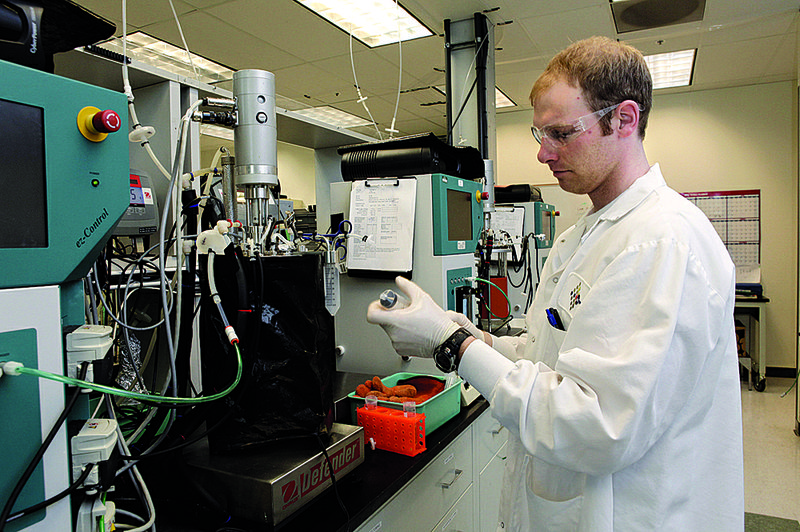SAN JOSE, Calif. — As one of the San Francisco Bay Area’s hottest biofuel businesses, Solazyme exemplifies to many everything that is right - or wrong - with the federal government’s efforts to wean the nation off foreign oil.
The South San Francisco firm has deals with the likes of Chevron and Honeywell. Its algae-based fuel was used in October for an unprecedented commercial airline flight. And in December it won a piece of a $12 million contract to supply biofuel for the Navy.
But critics contend the fuel costs the Navy too much, arguing that the contract amounts to at least three times what the military typically pays. And despite the subsidies Solazyme and other biofuel companies have received from the federal government, they argue, the nation appears nowhere close to meeting a congressional mandate to produce 36 billion gallons of biofuel by 2022.
At the same time, the nation’s dependence on foreign oil is declining, reducing the pressure to produce alternative fuels.
All that has raised the possibility that lawmakers and investors may cut support for biofuels, which could pose severe - if not catastrophic - problems for many of the companies like Solazyme that are struggling to provide an alternative at the gas pump.
“It could have a pretty serious impact,” said Jay Keasling, chief executive officer of the Joint Bioenergy Institute in Emeryville, Calif. Keasling has co-founded three California biofuel ventures: Lygos, Amyris and LS9.
“It’s crucial for the government to maintain consistent biofuel policies,” he said.
The aggressive federal efforts to spur the development of the biofuel industry stem from Congress’ decision in 2007 to set out the 36 billion-gallon-a-year goal. Ethanol already accounts for about 14 billion of the nearly 140 billion gallons of gasoline consumed in the United States annually. But instead of using only corn, the primary source of ethanol, lawmakers required other sources to meet the goal, including 16 billion gallons from “cellulosic” materials, such as switchgrass and wood chips.
That decision was partly to encourage farmers to keep growing corn for food. In addition, corn requires a large amount of fertilizer, and fuel made from corn emits more greenhouse gas than the cellulosic variety. But the tough fibers in sticks and grasses don’t easily break down into fuel.
The Congressional Research Service reported in January that “some investors find it extremely risky, perhaps even cost-prohibitive, to provide financial backing to cellulosic biofuel plants,” which are three times more expensive to build than corn ethanol factories.
In October, the National Research Council concluded that the mandate to produce 16 billion gallons of cellulosic biofuel is “unlikely to be met by 2022.” The Environmental Protection Agency has lowered the production expectations for cellulosic biofuel to just 8.65 million gallons this year. And two months later, Congress let a biofuel tax credit expire.
Calls for the government to stop subsidizing biofuel have been especially loud after the Navy announced in December that it is paying $12 million for 450,000 gallons of biofuel, with an undisclosed sum going to Solazyme under a subcontract. Critics contend the price is nearly four times what the Navy normally pays for fuel.
Some conservative commentators have complained that Solazyme - which also received a nearly $22 million grant from the U.S. Department of Energy in 2009 - only got the contracts because one of its advisers, T.J. Glauthier, also served as an energy adviser to President Barack Obama’s White House transition team.
During a congressional hearing last month, Sen. John McCain, R-Ariz., called the Navy deal potentially “another Solyndra situation,” a reference to the $535 million Department of Energy loan guarantee that Fremont, Calif., solar-panel firm Solyndra received before its bankruptcy.
Solazyme executives counter that their dealings with the federal government began during the Bush administration and that the price of their fuel will drop when they begin large-scale production over the next couple of years.
Although not profitable, the company - which was incorporated in 2003 and went public in May last year - has been consistently ranked among the hottest in the field by trade journal Biofuels Digest. And in addition to its government contracts, it drew considerable media attention last fall when United Airlines used its product for the nation’s first commercial biofuel-powered jet flight.
Solazyme’s technology uses algae, which naturally produce an oily substance. By nourishing the tiny organisms in fermentation tanks with everything from sugarcane to cellulosic materials, the company claims the oil that is produced can easily be refined into diesel and jet fuel.
Solazyme also touts the oil’s usefulness for other products, from cosmetics to flour, and it has deals with several corporations active in those markets. But it remains heavily focused on biofuel because that energy source is crucial to the nation’s future, Chief executive Officer Jonathan Wolfson said at a recent industry conference in San Francisco.
“At some point the world will run out of petroleum,” he said. “We need to develop alternatives.”
Business, Pages 19 on 04/23/2012
